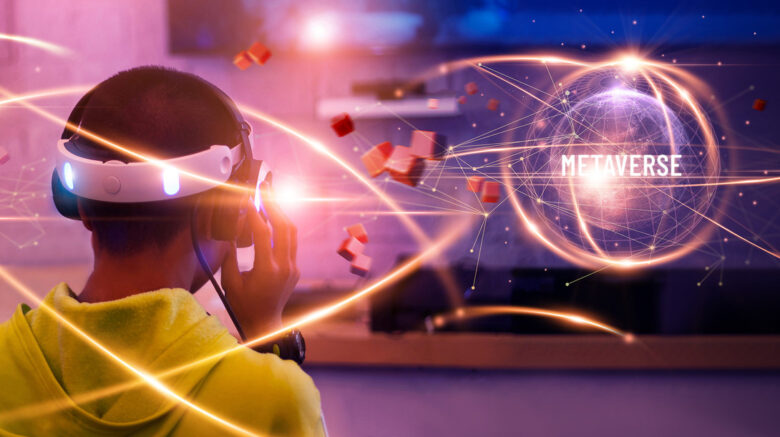The metaverse has completely changed the evolution of the gaming industry by fusing the physical and virtual worlds. It has now expanded beyond consoles and PCs into 3D worlds where players can interact, create, and even gain real value. Cryptocurrencies and blockchain technology have shattered barriers within in-game economies, allowing for digital assets to be truly owned via NFTs. Within the metaverse, socializing and competing in play-to-earn games provide a new level of entertainment. This article examines the evolution of gaming in the metaverse, the technologies spurring this evolution, and the prospective outlook for both gamers and developers.
From Pixels to Immersive Virtual Worlds:
Today’s metaverse video games have fully immersive 3D environments and are a huge leap from the days of merely pixelated 2D screens. Console classics and arcade games laid the foundation, but platforms like Roblox, Fortnite, and Decentraland elevate the experience by enabling players to explore endless landscapes, interact with other users in real time, and even attend virtual concerts. The use of VR and AR headsets makes gameplay even more lifelike. The transition from single-player games to online, persistent world interfaces has turned gaming into a social experience in which millions of people connect and engage in shared digital spaces every day.
Utilizing Blockchain and NFTs in Video Games:
The advancement of blockchain technology has allowed for a new paradigm in gaming, which is true digital ownership. Unlike typical games with in-game purchases tied to an account, metaverse games offer ownership, trading, and selling through non-fungible tokens. Play-to-earn games such as Axie Infinity and The Sandbox allow players to monetize their time and skills. Transparent transactions are facilitated by smart contracts, with rare item trading by gamers secured through decentralized marketplaces. Numerous economic opportunities have emerged with this shift, turning gaming into a viable career for many.
Play-to-Earn: A New Era of Gaming Economies
A paradigm shift in video games has been brought about by the play-to-earn (P2E) model in which players are compensated with cryptocurrency and NFTs. In-game microtransaction purchases are now replaced with earning real-world value for completing tasks, battling, or trading virtual assets. Splinterlands’ SPS tokens and Axie Infinity’s AXS tokens serve as rewards for in-game achievements and are converted to income. For developing countries, this model presents new opportunities as players use gaming as a livelihood. However, not all P2E games guarantee long-term profitability and pose concerns about unsustainable market volatility.
Social Interaction and Virtual Communities:
In the metaverse, gaming no longer centers only on competition. Socializing is becoming a larger part of the gaming experience. VRChat and Meta’s Horizons Worlds have expanded into social networks where players can attend or even host business meetings in digital spaces. With the advent of virtual concerts, such as Travis Scott’s on Fortnite, gaming platforms are emerging as entertainment venues beyond fortnights of gameplay. Guilds and clans in blockchain-based games encourage collaboration and active participation in games. These voicing-enriching social interactions will only develop with more immersive experiences in the metaverse. These developments will change how we experience games and social interaction online.
The Impact of VR and AR on Immersive Gameplay:
The introduction of new technologies has increased the level of immersion that VR and AR offer in games. With headsets such as the Oculus Rift and the PlayStation VR, players are being thrust into entirely new worlds where everything can be interacted with, as seen in AR games like Pokémon GO, which add elements to the real world. These technologies are already incorporated into the metaverse and allow players to walk, move, and gesture in a lifelike environment while pointlessly talking to others around them. With further developments in haptic feedback and motion tracking, gaming will be so realistic that even the most discerning players will find it difficult to distinguish from real-world experiences.
Challenges Facing Metaverse Gaming:
While the metaverse gaming industry is booming, it’s not without its challenges. Some players cannot access the gaming platforms due to the high prices of VR headsets and the fees associated with blockchain transactions. The digital assets of users are at risk due to security threats like NFT scams and hacking. In addition, the sustainability of these systems is called into question by the environmental impact of energy-consuming blockchain networks. Developers also need to address the equilibrium of in-game economies, server stability, and other aspects for fair play. These issues, if resolved, would increase the long-term viability of metaverse gaming.
The Future of Gaming in the Metaverse:
The gaming industry is leaning toward the development of a metaverse where players can travel seamlessly between different virtual realms. The use of blockchain technology will enhance interoperability, which, in turn, will enable assets to be transferred from one game to another. The design of video games will become much more engaging and responsive with artificial-intelligence-controlled NPCs and evolving world systems. As 5G and cloud gaming services advance, latency on different devices will be less of an issue, leading to an improved overall experience. The best platform for gaming is bound to be the metaverse, as it integrates entertainment, socialization, and economic opportunity in previously inconceivable methods.
Conclusion:
The creation of new ways of earning, socializing, and entertaining oneself comes with the addition of gaming in the Metaverse. It is enhanced by the development of VR and AI technologies, as well as blockchain, which makes virtual environments more feasible both socially and economically. Despite the existing issues of accessibility and security, the potential opportunities are astonishing. The current paradigm has changed from gamers being mere consumers to them becoming participants in decentralized digital economies. In the future, the metaverse is bound to integrate with technological advancements, promising to redefine the concept of entertainment along with the new paradigm of consoles, making games limitless for future generations.
FAQs:
1. What is the metaverse in gaming?
The clause refers to several intricate online universes equipped with trading and exploring systems, allowing players to buy and sell digital goods using blockchain technology.
2. How do NFTs change gaming experiences?
NFTs revolutionize the gaming experience as players can now sell, buy, or trade in the form of land, characters, or other items within the game’s framework in their personal possession.
3. What are play-to-earn games?
Providing real-world rewards for achieving stipulated tasks using in-game currency requires players to earn cryptocurrencies or NFTs.
4. What equipment is needed for metaverse gaming?
The player needs to have a PC or console to play the game; however, VR headsets, stable internet, and crypto wallets are mandatory for immersive experiences.
5. Will we continue to see metaverse games in the future?
Sure, with advancements in technology alongside additional corporate interest in virtual worlds, it is anticipated that gaming in the metaverse will become a dominant form of entertainment as well as a significant economic activity.




